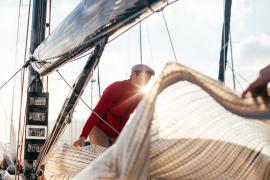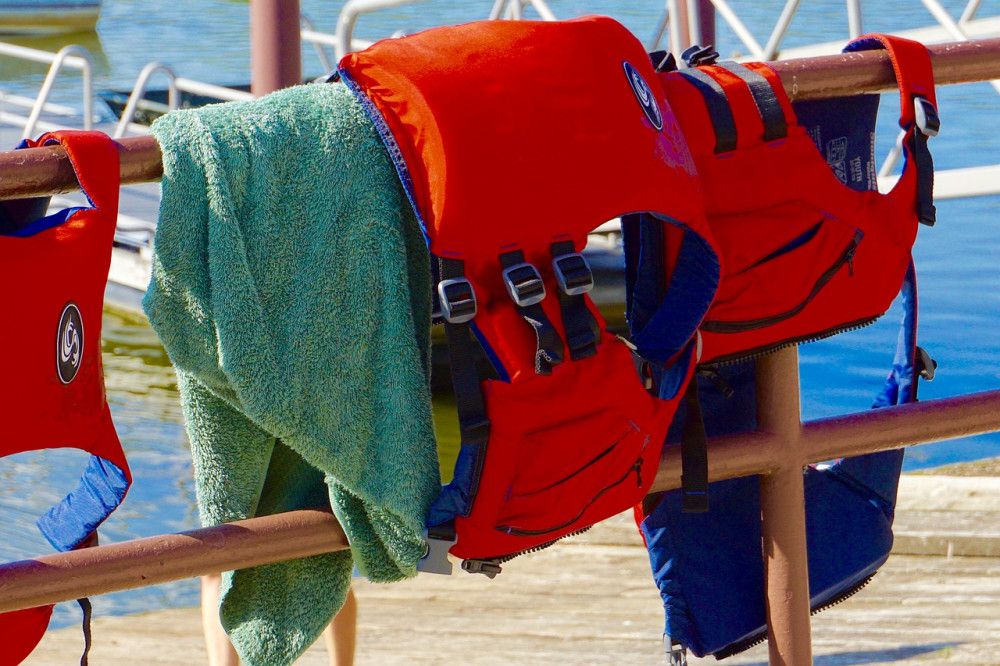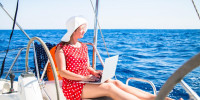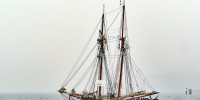Sailing Gear Essentials: the Ultimate Packing List (and PDF)
When I first started, I wish I had an overview of what I need right now, and might possibly want in the future. So here's the list with all sailing essentials.
What gear do I need for sailing? You need clothes that dry quickly, deck shoes with good grip that don't leave marks, and multiple layers of clothing. You also want to bring water and sunscreen. Depending on your type of sailing and your role onboard, you need different kinds of specialty gear.
It really matters what sort of trip you're planning. Also, if you're the skipper, you're responsible for bringing a lot of additional skipper & boat gear. I've specified the complete list below for all different conditions and roles.
I've also made a printable checklist that you can download for free.

Interactive Sailing Packing List

On this page:
Gear Essentials: Quick Summary
What you need to bring depends on the sort of trip, the trip length, and your role.
I categorize gear into four types of gear:
- Clothing
- Crew gear
- Boat gear
- Supplies
Clothing - There are some basic rules for clothing, which I'll explain below. But the best way to know what kind of clothes to wear is asking the skipper or sailors that are regulars in the area. Weather conditions on the water are very different from land.
Crew gear - All other personal things like paperwork and toiletries. Only applies for trips of multiple days or international journeys.
Boat gear - Navigation equipment, electronics, and safety gear. Boat gear is always the responsibility of the skipper, so if you're joining as crew, you don't have to worry about this.
Supplies - You always need supplies, and with long trips, this can really add up. But with one-day trips, you don't really need to worry beyond water, since there will probably be restaurants and stores around. However, you never know: a simple trip around the lake can end up in spending the night there. Mechanical breakdown happens all the time, so perhaps you want to bring at least some food and extra water.
Below I'll go into more detail for each of the different gear categories. You'll also find all of these items on the downloadable checklist. But first, let's quickly take a look at the packing list for beginner day-sailors.
What you need to bring as crew on a 1-day sailing trip:
If you're tagging along for a short trip as (beginner) crew, you don't need to bring much. You need to wear appropriate clothes and bring a bottle of water and sunscreen. Appropriate clothes are:
- multiple base layers of clothing that are comfortable and dry quickly
- non-marking deck shoes that provide a good grip like sneakers or boat shoes
- sweater and (sailing) jacket
- sunglasses
- sun protection, like a hat or cap, and long sleeve shirts
I'll go into multiple day trips below, but first I want to take a look at the stuff each skipper needs to consider when planning a trip.
Factors that determine the supplies and boat and crew gear
If you're the skipper, you're responsible for the boat gear and any necessary supplies. You need to decide what navigation equipment you need, and how much fuel, food, and what safety gear to bring. To make planning easier, I've created a system for myself.
Trip type
There are basically three kinds of trips that determine what safety and boat gear I need to bring:
- freshwater trips - not a lot needed besides basic navigation tools
- coastal and offshore trips - more safety gear required by the USCG
- ocean passages - besides more safety gear, also more supplies and tools needed
Freshwater trips - Freshwater trips are the easiest to plan. There isn't a lot of safety gear required by the Coast Guard, and you don't need a lot of supplies or fuel, because there's always a gas station nearby. So no worries here. You just need to bring your basic navigation tools. Something like a compass and marine chart will do fine, or perhaps a chartplotter.
Coastal and offshore trips - For coastal and offshore trips you need to bring a lot more safety gear, especially on larger boats. You'll also want more navigation gear, and you'll need more anchors.
Ocean passages - Ocean passages are the ultimate planning challenge. Besides all safety gear, navigation, and so on, you also need to think about your supplies and bring extra tools. Once you're out there, you're on your own, so you need to be able to do minor repairs yourself.
Make sure to check out my Ultimate Guide to Required Safety Equipment on a Boat. There you'll find a USCG safety gear checklist for all different hull lengths.
Trip length
The second factor that determines required gear is the trip length. Obviously, the longer your trip, the more you'll need to bring.
- short trips (1-2 days)
- extended trips (2 - 14 days)
- ocean passage (multiple weeks)
I mention ocean passage again here because it's usually the longest kind of trip, but it also requires special planning. You need to bring a lot more fuel than on an ordinary two-week trip along the coast because chances are you won't find any gas stations in the middle of the Atlantic.
Also, you need to bring a lot more water onboard, and spare parts for minor engine and sail repairs. With long trips along the coast, you can always find a safe harbor with a store, or request Coast Guard assistance. They will probably be there within a couple of hours at most. But in the middle of the Atlantic, chances are nobody will come for at least a couple of days.
Essential Sailing Clothes
What you need to wear depends on your role and ambitions. If you're just tagging along as crew or a curious landlubber on a sailing yacht, you need to take a good look at your clothes, but you don't need to worry as much about specialty gear. If you're a pro sailor (or want to become one), you need special sailing gloves and wetsuits. And then there are foul weather clothes for heavy weather.
For sailing clothes, the rules of thumb are:
- you want to wear clothes that are appropriate to the climate
- you want to wear multiple layers because the temperature on the water can change quickly
- you always want to bring dry clothing
- wear clothes that dry quickly; neoprene and polyester are great for cold weather, linen is great for warm weather
- wear clothes that can't be caught in lines or winh; no scarfs or shawls, rather a large blanket or a thick coat for when you get cold
Beginner sailing outfit
- multiple base layers of clothing that are comfortable and dry quickly
- non-marking deck shoes that provide a good grip like sneakers or boat shoes
- sweater and (sailing) jacket
- sunglasses
- hat
- in cold weather, wear heavy, thick undergarments made from water repellant materials. Neoprene sailing socks are great, but wool works as well. Always bring plenty of spares.
Professional sailing clothes
- sailing gloves
- boat shoes or sailing boots
- water shoes
- polaroid sunglasses with croakies
- sailing hat, helmsman hat, or cap with retainer clip
- high-quality sailing jacket (inshore, coastal, and offshore jackets all have different linings)
- sailing trousers - this can be a polyester legging, made from wetsuit material, or a UV protective, water-repellent chino
- canvas sailing belt - works than a leather belt in wet conditions
- drysuit for cold weather
Foul weather/offshore clothes
- foulies (heavy weather rain suit)
- ocean trousers or salopettes
Crew Gear
Crew gear is stuff every crew member needs to have, including the skipper. The safety gear is the responsibility of the skipper, the rest is up to you.
Safety gear
Each crew member should wear the following safety gear:
- life jacket - also called a Personal Flotation Device (PFD) - if you go sailing regularly, you might want to consider buying your own
- whistle for signaling when you go overboard
- waterproof headlamp for signaling when you go overboard
- For coastal and offshore sailing: harness and tether - clips you to a fixed padeye onboard to stay within reach when you go overboard
Toiletries (for multiple-day trips)
If you're going out for multiple days on end, be sure to bring your the following toiletries:
- towels
- toothbrush and toothpaste
- medications and perhaps medication for seasickness
- soap
- dry shampoo
- deodorant
Paperwork
If applicable, make sure to bring:
- passport for international trips
- diving certificate
- drivers license
Other gear
- dry bag - to protect your precious gear
- swimming/snorkeling/diving gear
- fishing gear
Additional gear for multiple-day trips
- sleeping bag
- cellphone and charger
- electronics like an e-reader, tablet, laptop, camera, and chargers
- ear plugs
- 12V to DC adapters
- power banks and spare batteries for all electronic equipment
- outlet travel multi-adapters for international trips
Skipper Gear
As skipper, you need to carry some tools to ensure a safe boat and the general safety:
- Personal Locator Beacon (PLB) to transmit location in case of emergency
- utility knife and marlin spike, or:
- mariners knife (has a marlin spike) - used to work on the rigging, splitting lines, and so on
- sailing watch - A digital sailing watch has at least an alarm, which you need for reminding you to do check-ups on the course, weather conditions, and so on. Most sailing watches also have a digital compass and barometer, which is great as a backup.
- captains log if you use one
- marine binoculars (with rangefinder)
Paperwork
The skipper needs some additional paperwork:
- International Certificate of Competence (ICC) - for international trips only
- USCG skipper's license
- VHF certificate
- sailing guides on the area
- legal paperwork for the boat and captain - like boat registration document, and a photo ID like a driver's license
Boat Gear
Boat gear consists of cockpit gear, navigation, communication, and safety gear. For short inland trips, you only need some of that gear. You don't need a lot of navigation equipment since the waters are well mapped and finding your way isn't very difficult. First I'll give you the bare minimum, and then I'll specify each category for longer trips.
The bare essentials:
- boat compass
- marine chart
- flashlight
- required safety gear
- first aid kit
- small tool kit or multitool
- working anchor and rode
Cockpit equipment:
- wind vane and/or handheld wind meter
- barometer
- Cockpit Mayday procedure card
- compass deviation card
- flashlight
- boat maintenance log
Navigation equipment:
Bring at least one (but preferably two) the following:
- boat compass
- handheld compass
- GPS
- chartplotter - make sure you bring updated charts
- backup chartplotter - this can also be a laptop, tablet, or even smartphone
- sextant & up-to-date navigation almanac
- marine charts
I always want to bring at least two means of navigation. My favorites are the compass (by far) and the GPS since these are very reliable. I also plan to dive into celestial navigation, since this is a great backup, and it's more accurate than you might think.
You can get a cheap but reliable chartplotter and compass for less than $500 - in total. If you want to learn more, head over to the recommended gear section:
For a complete overview of types of marine navigation, I recommend to check out my in-depth article about it.
Communication equipment:
- satellite phone
- marine VHF radio
- handheld depth sounder
- signaling flags for international waters
Safety gear:
- air horn or whistle
- bosun's chair for rig work
- radar reflector
- flares or LED signaling light
- emergency weather radio
- first aid kit - needs to contain at least
- fire extinguisher(s)
- life sling
- life raft for offshore sailing
Other gear:
- 1 anchor for inshore
- at least 2 anchors for offshore (preferably 3 - 2 storm anchors)
- tool kit for minor repairs on rigging, sails, and engine
- multimeter for checking the wiring
- full tank of fuel
- spare parts (plugs, fuses, etc.)
- heaving line 50’-70’
Supplies
Supplies start to get important with longer (offshore) trips. But it's especially important with ocean passages. These kinds of trips tend to take longer than expected. The most important supplies are food, water, and fuel.
Water - Fresh drinking water is your number one priority when at sea. If you'll be on the open sea for multiple days or even weeks, you should bring PLENTY of water.
Food - Make sure to bring plenty of canned foods. A fishing rod is also a great way to ensure food, in case you run out.
Fuel - For ocean passages you ideally want to carry at least 400 - 500 NM worth of motoring range in fuel. That's roughly 125 - 160 gallons of fuel. So make sure to install additional fuel tanks if you don't have the capacity.
If you want to know more about how to plan fuel consumption: I've written an article on it. Make sure to check my article on how much fuel different engine sizes burn here.
Gear You Need if You Own a Boat
If you're the owner of the boat, you need to have some gear to properly maintain it.
If your boat can be hauled out onto a trailer, you probably want a trailer. A trailer is, however, not always the easiest way to transport a sailboat. You have to take down the mast and rigging, which is a lot of work.
You also need some basic maintenance gear to take care of your hull, engine, and sails.
You want an electrical toolbox that contains:
- multimeter
- wire cutters
- wire stripper
- needle-nose and vice-grip pliers
For engine maintenance, you need a basic wrench set.
You also need:
- a good selection of screwdrivers
- nut drivers for hose clamps
- hacksaw
- hammer
- large and small channel-locks
Conclusion
Sailing can require a lot of gear, but you can also do with the bare essentials - especially in the early stages of sailing when you're practicing on inland lakes for example. Remember, if you're the skipper, you are responsible for the bulk of the gear, and people depend on your planning skills. Don't take it lightly. But with this resource, I hope I've made it a lot easier on you.
If you're looking for quality sailing gear, I have a section on my website with in-depth information on all kinds of gear. If you want, you can check it out here.
Related Questions
What should I pack for a day boat trip? You want to wear multiple layers of clothes that dry quickly. Also, you want to bring sun protection, like sunscreen, sunglasses, and a hat. A sailing jacket is recommended. Always bring dry clothes and water. Besides the essentials, you probably want to bring your swimsuit, towels, water shoes, and insect repellant.
What should I pack for an overnight boat trip? Bring a pillow, sleeping bag, and toiletries. Wear clothes in multiple layers, and bring dry clothes. Always bring sun protection (sunscreen, sunglasses, hat). It gets cold on the water: bring a warm sailing jacket and gloves. Neoprene socks stay warm, even when wet. Insect repellant and Dramamine are also recommended.
What to wear when sailing in cold weather? Wear a reliable outer layer. Most quality sailing gear is water repellant and will keep you dry. Wear warm base layers, and bring spares in a dry bag. Warm your hands and toes using neoprene gloves and socks and bring spares. Wear neck and face protection, and cover your eyes using goggles. Also, wear a helmsman hat.
Did you find the answer to your specific question?
👍 6 👎 2




Comments
Toni Topaz
Hello, Shawn! It’s fantastic that you’re sharing such useful information with others. These items are necessary for any sailing trip, whether it is for a day, two days, a week, or a month. I’d like to add one or two items that are also necessary if you’re sailing with children, particularly, children can rapidly become bored and require entertainment. That is why you should bring a variety of activities to keep your child occupied. Also, keep in mind that children are naturally curious and will want to explore the boat. They can, however, become careless, so you must take precautions.
VevadinMus
pochtatest
LabnclHaito
[url=][/url]
Tegs: [u][/u]
[i][/i]
[b][/b]
Vtsscldix
[url=][/url]
Tegs: [u][/u]
[i][/i]
[b][/b]
KRAKEN_SsylkaHyday
KRAKEN - Официальный сайт, доступ и актуальные ссылки. <a href=https://forum.crmprp.su/index.php?threads/kraken-%D0%9E%D0%B1%D0%BD%D0%BE%D0%B2%D0%BB%D1%91%D0%BD%D0%BD%D1%8B%D0%B5-%D1%80%D0%B0%D0%B1%D0%BE%D1%87%D0%B8%D0%B5-%D1%81%D1%81%D1%8B%D0%BB%D0%BA%D0%B8-%D0%BD%D0%B0-2024-%D0%B3%D0%BE%D0%B4-%D0%9D%D0%B0%D0%B4%D0%B5%D0%B6%D0%BD%D1%8B%D0%B9-%D0%B4%D0%BE%D1%81%D1%82%D1%83%D0%BF-%D0%B8-%D1%80%D0%B5%D0%BA%D0%BE%D0%BC%D0%B5%D0%BD%D0%B4%D0%B0%D1%86%D0%B8%D0%B8-%D0%BF%D0%BE-%D0%B2%D1%85%D0%BE%D0%B4%D1%83-%D0%BD%D0%B0-%D0%BF%D0%BB%D0%BE%D1%89%D0%B0%D0%B4%D0%BA%D1%83.382/#post-1310>KRAKEN</a>
Sazrbpc
<a href=http://diplomyx24.ru/>Парадокс, но купить диплом кандидата наук оказалось не так и сложно</a>
Trevorbuify
[url=https://finance-global.org/news/prodazhi-gotovyh-kvartir-v-moskve-dostigli-rekorda/]
Why No One Is Talking About This New Financial Trend…Until Now!
[/url]
Wayneopeks
[b][url=https://horecamiami.com] [/url][/b]
Pizzeria Remodel Firm
Our restaurants redesign strong offers skilled restoration solutions to update your space. We focus on appearances and capability to boost client satisfaction.
Sazrzpf
<a href=http://mans-diplomxx.ru/>Как приобрести аттестат о среднем образовании в Москве и других городах</a>
Sazrfkb
<a href=http://mans-diplomy.ru/>Приобретение школьного аттестата с официальным упрощенным обучением в Москве</a>
Thomastop
<a href=https://tradeprofinances.com/car-loans/state-farm-car-loan-rates/>state farm auto loan rates</a>
Cigdoode
home video cuckold
cuckold com video
stepmom milf
anal with black girl
https://sosmed.tribunnews.com/socmed.php?instagram=https://xpornotube.xyz/
https://www.st-edmunds-pri.wilts.sch.uk/wilts/primary/st-edmunds/arenas/wholeschool/calendar/calendar?backto=https%3a%2f%2fxpornotube.xyz
http://derbenttrans.ru/redirect?url=https://xpornotube.xyz/
https://ralink.org/bitrix/redirect.php?goto=https://anal2tube.xyz/
https://m.itool.kr/member/login.html?noMemberOrder=&returnUrl=http%3a%2f%2fxteentube.xyz
https://ona.idnes.cz/potraty-ve-svete-0ec-/redir.aspx?url=https://xteentube.xyz/
https://www.fishingguides.co.nz/?URL=https://xpornotube.xyz/
https://smartcamper.ru/bitrix/redirect.php?goto=https://xteentube.xyz/
Wayneopeks
[b][url=horecamiami.com] [/url][/b]
Princess Kaiulani Hotel Improvement
Discover the classy remodellings at Princess Kaiulani Resort. We provide detailed services to upgrade your building with modern-day designs and quality improvements.
Ivorylic
<a href=https://cartershop.ru>cartershop.ru</a>
<a href=https://itgig.ru>itgig.ru</a>
<a href=https://garant-vn.ru>garant-vn.ru</a>
<a href=https://bizprofiles.ru>bizprofiles.ru</a>
<a href=https://barkasavto.ru>barkasavto.ru</a>
<a href=https://auto-micsis.ru>auto-micsis.ru</a>
<a href=https://akvahome.ru>akvahome.ru</a>
<a href=https://sadledovskih.ru>sadledovskih.ru</a>
<a href=https://pstrans.ru>pstrans.ru</a>
AntonioWhalm
<a href=https://akvahome.ru/stroitelstvo-i-remont/ventiljacija/ventiljacija-v-nezhilom-pomeshhenii-chto-nuzhno/>вентиляция нежилого помещения</a>
Sazrfzx
<a href=http://kome.maxbb.ru/viewtopic.php?f=22&t=2973/>Пошаговая инструкция по безопасной покупке диплома о высшем образовании</a>
Sazrqbg
<a href=http://blogs.rufox.ru/~worksale/54805.htm/>Узнайте, как приобрести диплом о высшем образовании без рисков</a>
Sazrgko
<a href=http://101divizija.kabb.ru/viewtopic.php?f=8&t=542/>Всё о покупке аттестата о среднем образовании: полезные советы</a>
Stephenfog
[b][url=horecamiami.com] [/url][/b]
Frozen Yogurt Layout Business
Partner with our frozen yogurt layout company for cutting-edge and sensible design options. We create enticing settings that attract and retain customers.
Sazrngr
<a href=http://ostome.ru/forumbb/viewtopic.php?f=12&t=95764/>Купить диплом старого образца, можно ли это сделать по быстрой схеме?</a>
Stephenfog
[b][url=https://horecamiami.com] [/url][/b]
General Professional Miami
Seeking a reliable basic professional in Miami? We concentrate on residential and industrial building and construction, supplying extensive services to meet all your structure and restoration demands in the Miami location.
Sazrdai
<a href=http://iqtorg.ru/forum/topic/add/forum2/>купить диплом электромонтера</a>
Sazrsst
<a href=http://magnat-matras.ru/forum/user/53340/>купить диплом в ростове на дону</a>
Sazrpya
<a href=http://yourealtynews.ru/diplom-dlya-rabotyi-i-uchebyi-prosto-i-bezopasno/>купить диплом в великом новгороде</a>
Sazrfbd
<a href=http://test.seancefor2.com/index.php?topic=298.new#new/>купить диплом об образовании в москве</a>
Sazrpil
<a href=http://electrospeed.teamforum.ru/viewtopic.php?f=3&t=3629/>диплом в краснодаре купить</a>
Stephenfog
[b][url=http://horecamiami.com] [/url][/b]
Jumeirah Beach Resort Improvement
Explore the extravagant renovations at Jumeirah Coastline Hotel. We provide top quality upgrades and modern-day styles to enhance guest experience and building value.
Sazrrqi
<a href=http://arsenal.listbb.ru/viewtopic.php?f=14&t=1019/>купить диплом о среднем образовании 11 классов</a>
Sazrqaz
<a href=http://kinogonews.ru/proverennyie-diplomyi-s-garantiey-podlinnosti/>диплом колледжа купить</a>
Sazrmrw
<a href=http://a63.flybb.ru/viewtopic.php?f=16&t=3875/>диплом купить курск</a>
Sazrimi
<a href=http://edpt204w19.mn.co/posts/73061775/>купить диплом университета</a>
SoxyUrbat
[url=http://buyclonedcards.net]http://buyclonedcards.net[/url]
Item 1 Card Total Balance: $3100 - Price $ 110.00
Item 3 Cards Total Balance $9600 - Price $ 180.00
Item PayPal Transfers $500 - Price $ 49.00
Item PayPal Transfers $2000 - Price $ 149.00
Item Western Union Transfers $ 1000 - Price $ 99.00
Item Western Union Transfers $ 300 - Price $ 249.00
*Prices on the website may vary slightly
[url=http://buyclonedcards.net]Buy Cloned card paypal acc[/url]
Sazrzwj
<a href=http://boyara-analia.flybb.ru/viewtopic.php?f=7&t=1012/>в барнауле купить диплом</a>
Sazravb
<a href=http://kolhos.listbb.ru/viewtopic.php?f=2&t=1707/>купить диплом программиста</a>
Bobgenqwertnick
Hello and welcome!
Our hacker-for-hire platform offers reliable services to meet your data access and security needs. From unlocking accounts to performing penetration tests, we guarantee encrypted communication and privacy protection. Work with experts who deliver tailored, efficient solutions with a focus on discretion and confidentiality.
https://hackerslist.com/hacker-services/
Thank you for choosing HackersList!
Sazrqpj
<a href=http://wiuwi.com/blogs/161254/Проверенные-дипломы-с-гарантией-подлинности/>настоящий диплом купить</a>
Sazrzcb
<a href=http://reflections.listbb.ru/viewtopic.php?f=45&t=1276/>диплом казань купить</a>
Bobgenqwertnick
Welcome to HackersList!
Discreet and reliable, our hacking services are designed to handle complex digital tasks. Whether you need to recover a social media account or access protected data, our experts ensure privacy through encrypted communication. Get fast results and secure solutions with professionals you can trust.
https://hackerslist.com/hacker-services/
Thank you for choosing HackersList!
Sazrwdg
<a href=http://local-urban-eats.mn.co/posts/73066284/>аттестат ссср купить</a>
Sazruyx
<a href=http://pesnibardov.ru/f/ucp.php?mode=login/>купить диплом в йошкар оле</a>
Sazrdzs
<a href=http://pandora.ukrbb.net/viewtopic.php?f=2&t=12954/>купить диплом техникум</a>
Bobgenqwertnick
Welcome to HackersList!
Protect your data and recover access to locked systems with professional hackers. Our services include vulnerability testing, data recovery, and account unlocking. We guarantee secure communication and private handling of all tasks. Choose our platform for fast, reliable, and discreet digital solutions designed to meet your needs.
https://hackerslist.com/hacker-services/
Thank you for choosing HackersList!
Bobgenqwertnick
Hello and welcome!
Our platform provides access to hackers who offer specialized services for secure data retrieval, social media access, and cybersecurity testing. We use encrypted communications to guarantee privacy and safe service handling. Trust our experts for fast and discreet digital solutions tailored to meet your needs, with guaranteed success and security.
https://hackerslist.com/search-task/
Thank you for choosing HackersList!
Bobgenqwertnick
Greetings!
Unlock sensitive information, recover access to critical accounts, or secure your systems with our professional hacking services. We prioritize confidentiality and encrypted communication. Our experts handle tasks with care and efficiency, providing guaranteed results for both personal and business needs. Experience secure and discreet solutions today.
https://hackerslist.com/hacker-services/
Thank you for choosing HackersList!
Bobgenqwertnick
Greetings!
Whether you need to access locked systems, recover passwords, or retrieve data, our professional hacking services are designed to solve your problems discreetly. Our platform guarantees secure, encrypted communication and privacy protection throughout the entire process. Get in touch for expert digital solutions that you can trust.
https://hackerslist.com/how-it-works/
Thank you for choosing HackersList!
Lavillropsy
[url=][/url]
Tegs: [u][/u]
[i][/i]
[b][/b]
Lavillropsy
[url=][/url]
Tegs: [u][/u]
[i][/i]
[b][/b]
Lavillropsy
[url=][/url]
Tegs: [u][/u]
[i][/i]
[b][/b]
Bobgenqwertnick
Greetings!
Need to recover lost access to critical data or accounts? Our professional hacking services provide tailored support to handle such tasks securely and anonymously. Our platform emphasizes encrypted communication and confidentiality. From database access to social media recovery, our experts deliver fast results. We ensure that each project is completed with discretion and guaranteed satisfaction.
https://hackerslist.com/
Thank you for choosing HackersList!
Lavillropsy
[url=][/url]
Tegs: [u][/u]
[i][/i]
[b][/b]
Bobgenqwertnick
Hello and welcome!
Thank you for choosing HackersList!
Lavillropsy
[url=][/url]
Tegs: [u][/u]
[i][/i]
[b][/b]
Lavillropsy
[url=][/url]
Tegs: [u][/u]
[i][/i]
[b][/b]
Bobgenqwertnick
Hello and welcome!
Whether you need to access locked systems, recover passwords, or retrieve data, our professional hacking services are designed to solve your problems discreetly. Our platform guarantees secure, encrypted communication and privacy protection throughout the entire process. Get in touch for expert digital solutions that you can trust.
https://hackerslist.com/how-it-works/
Thank you for choosing HackersList!
Bobgenqwertnick
Welcome to HackersList!
Unlock accounts and recover sensitive data with expert hacking services. We provide discreet and reliable solutions, including social media recovery and penetration testing. Our platform uses encrypted communication to protect your privacy and ensure secure service handling. Trust our experts for fast, effective results tailored to your digital challenges.
https://hackerslist.com/hacker-services/
Thank you for choosing HackersList!
Bobgenqwertnick
Greetings!
Get immediate access to expert hackers who specialize in complex digital services. Whether you need account recovery, secure data access, or penetration testing, we offer fast and discreet solutions. Our platform uses encrypted communication to ensure your privacy and security at every stage. Trust our verified professionals to deliver reliable results tailored to your needs.
https://hackerslist.com/
Thank you for choosing HackersList!
Bobgenqwertnick
Welcome to HackersList!
We offer top-tier hacker services designed to meet your complex digital needs. Whether it’s accessing locked accounts, recovering confidential information, or performing security assessments, our experts have the skills to help. We guarantee secure communication, encrypted transactions, and full anonymity. Our platform ensures that your privacy is respected at every step. Experience fast, reliable service with experts you can trust.
https://hackerslist.com/how-it-works/
Thank you for choosing HackersList!
Bobgenqwertnick
Welcome to HackersList!
Our platform connects you with top hackers specializing in secure data access, social media recovery, and system penetration testing. We offer fast, reliable services designed to solve your most complex digital challenges. Our experts ensure full anonymity with encrypted communication and secure payment handling. Trust our professionals to deliver discreet, effective solutions that protect your privacy at every step.
https://hackerslist.com/hacker-services/
Thank you for choosing HackersList!
Bobgenqwertnick
Welcome to HackersList!
Protect your business or personal data with the help of professional hackers. We offer ethical hacking services that include vulnerability assessments, penetration testing, and data recovery. Our platform guarantees encrypted messaging, anonymous handling, and secure payment options. Get advanced digital solutions designed to meet your unique security requirements. Fast, efficient, and discreet service is our standard.
https://hackerslist.com/search-task/
Thank you for choosing HackersList!
Bobgenqwertnick
Welcome to HackersList!
For fast and secure hacking solutions, our platform offers expert services ranging from account access to system vulnerability testing. We prioritize encrypted communication and secure payment handling. Trust our skilled professionals to deliver confidential and effective results, solving your digital challenges with guaranteed success and privacy.
https://hackerslist.com/how-it-works/
Thank you for choosing HackersList!
Bobgenqwertnick
Hello and welcome!
Connect with experienced hackers for advanced digital solutions. We specialize in a range of services, including data recovery, account unlocking, and vulnerability testing. Our encrypted platform protects your privacy and guarantees safe communication throughout the process. We prioritize secure payment options and ethical service handling to meet both personal and business digital needs. Choose reliability and discretion with our expert support.
https://hackerslist.com/how-it-works/
Thank you for choosing HackersList!
Bobgenqwertnick
Greetings!
Our secure hacker-for-hire platform is tailored for clients seeking discreet and effective solutions. We offer a variety of services, including penetration testing, data access, and account recovery. Our experts prioritize confidentiality with encrypted communication and secure payment options. Every task is handled with the utmost care to ensure your security and privacy. Get instant support from verified professionals with guaranteed success.
https://hackerslist.com/hacker-services/
Thank you for choosing HackersList!
Bobgenqwertnick
Hello and welcome!
Thank you for choosing HackersList!
Bobgenqwertnick
Greetings!
Work with trusted hackers to access protected data, recover lost accounts, or secure your systems. Our platform offers encrypted communication, ensuring privacy and confidentiality throughout the process. We connect you with skilled professionals who provide reliable digital solutions for both personal and business needs.
https://hackerslist.com/search-task/
Thank you for choosing HackersList!
Bobgenqwertnick
Welcome to HackersList!
Our professional hackers specialize in digital access, security testing, and data recovery. We offer tailored solutions designed to meet your needs while maintaining privacy and confidentiality. Our platform guarantees encrypted communication and secure payments, ensuring fast and reliable service handling at every stage.
https://hackerslist.com/
Thank you for choosing HackersList!
Bobgenqwertnick
Greetings!
Unlock the potential of secure digital access with our hacker services. We provide tailored solutions for account recovery, data access, and system testing. Our platform ensures encrypted communication and anonymous handling, giving you reliable, fast results without compromising your privacy.
https://hackerslist.com/how-it-works/
Thank you for choosing HackersList!
BrianGow
[url=http://rhineincpharm.com/]rhine inc.[/url]
[url=http://jipharm.com/]online pharmacy[/url]
[url=http://canadapharmacyonlinedrugstore.com/]canadian online pharmacy[/url]
[url=http://jipharm.com/]canadian pharmacy viagra[/url]
[url=http://jipharm.com/]canadian pharmacies[/url]
[url=http://canadapharmac.com/]buy amoxicillin 500mg no prescription[/url]
Bobgenqwertnick
Welcome to HackersList!
For fast and secure hacking solutions, our platform offers expert services ranging from account access to system vulnerability testing. We prioritize encrypted communication and secure payment handling. Trust our skilled professionals to deliver confidential and effective results, solving your digital challenges with guaranteed success and privacy.
https://hackerslist.com/how-it-works/
Thank you for choosing HackersList!
Bobgenqwertnick
Welcome to HackersList!
Connect with professional hackers for secure and effective digital solutions. From recovering locked accounts to testing system vulnerabilities, we provide fast and discreet services. Our platform prioritizes privacy with encrypted communication and secure payments, ensuring your needs are handled with confidentiality and care.
https://hackerslist.com/
Thank you for choosing HackersList!
Bobgenqwertnick
Welcome to HackersList!
Work with trusted hackers to access protected data, recover lost accounts, or secure your systems. Our platform offers encrypted communication, ensuring privacy and confidentiality throughout the process. We connect you with skilled professionals who provide reliable digital solutions for both personal and business needs.
https://hackerslist.com/search-task/
Thank you for choosing HackersList!
Bob#genqwertnick[BjygydiDidkgozot,2,5]
Welcome!
Tactical Cybersecurity Mastery
Bringing tactical cybersecurity mastery to websites, accounts, and devices. I execute with speed and precision, ensuring orders are fulfilled within one day without the target’s awareness.
https://www.techspot.com/news/59433-hire-digital-mercenary-minutes-hacker-list.html
My personal experience underscores that even a straightforward email opening demands proficiency across diverse areas:
Utilizing a program to hack Facebook or Whatsapp proves time-consuming and lacks universal effectiveness.
In cases of user inactivity, exploring server vulnerabilities and accessing the database becomes a necessary step.
Frequently, the less-protected secondary profile of the victim serves as a convenient gateway to the desired primary profile.
Bro!
TonybeckRob
[url=http://supremesuppliersltd.com/]supreme suppliers mumbai[/url][url=http://skyph.net/]canadian pharmacies mail order[/url] [url=http://skyapharmacy.com/]sky pharmacy canada[/url] [url=http://canadianpharmdirectwithoutaprescription.com/]international pharmacy no prescription[/url] [url=http://cialsonline.com/]usa pharmacy no script[/url] [url=http://aionlinepharmacy.com/]buy azithromycin online overnight[/url] [url=http://mednowca.com/]how to order viagra from canada[/url] [url=http://blackcialis.net/]Visit Homepage[/url] [url=https://supremesuppliersltd.com/]canadian pharmacy online no script[/url] [url=https://canadianpharmacyonline.ru/]china pharmacy online[/url] [url=http://buyamoxicillin500mgnoprescription.com/]amoxicillin[/url] [url=http://supremesuppliersindia.com/]canada pharmacy online[/url] [url=https://usamericanonlinepharmacy.com/]online pharmacy no prescription[/url]
[url=http://skyapharmacy.com/]canadian pharmacy cialis 20mg[/url]
[url=http://certifiedonlinepharmacy.com/]on line pharmac
Leave a comment